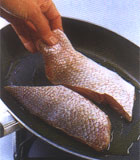|
The purpose of sautéing seafood is to
give it a crisp, lightly browned crust. The seafood is cooked in butter
(clarified is best because it doesn't burn over high heat) or oil over
intense heat, so that the outside of the food browns quickly before the
inside overcooks. It's easiest to cook small shellfish such as scallops or
shrimp by tossing them in a pan with sloping sides; the sloping sides make
the tossing motion easier. Whole fish, fish fillets and steaks would fall
apart if tossed that way, so they are browned on one side and then
carefully turned with a spatula.
Fish steaks, thick fillets, and small
thin whole fish such as sole or trout are the simplest to sauté because
they cook through in about the same amount of time it takes the exterior
to brown. Thin fillets, especially from fragile fish such as flounder,
fall apart if overcooked by even a few seconds, so watch them carefully.
It is preferred to cook fillets with the
skin on, because the skin holds the fillet together, tastes deliciously
crispy and looks good (exceptions are fish with thick or leathery skin,
such as grouper and blackfish.) But skin tends to stick, so use a nonstick
pan or a well-seasoned skillet. Fish skin also contracts when hot, causing
the fillet to curl. To prevent curling, start the fillet flesh side down,
cooking it for a minute or two to allow the flesh to contract. Then turn
the fillet skin side down and press down with the back of a spatula as it
cooks to prevent it from curling and to keep the skin in contact with the
bottom of the pan so its entire surface browns.
Sautéing is an excellent way to prepare
almost any small whole fish or fillet. The fish is coated with flour and
then sautéed in butter (preferably clarified). Flouring - or breading - is
particularly useful when cooking thin fish such as Dover sole, because the
flour speeds up browning (flour and breading brown faster than the
unadorned fish itself would) and so prevents the fish from overcooking.
Once cooked, the fish is transferred to a platter or plates and sprinkled
with lemon juice. The butter used for sautéing is discarded and fresh
whole butter is cooked in the pan until it barely begins to brown - at
which stage it is called "noisette" - and spoon over the hot fish.
Saute
Skin-on Red Snapper Fillets
|
1. The small pin bones running down the head end of the
fillet can be pulled out but this is laborious and often tears the
flesh. To avoid this, just cut along each side of the strip of pin
bones and remove the whole strip. |
 |
|
2. Cut the fillets into 2 equal pieces of similar shape. |
 |
|
3.
Season the fillets with salt and pepper. Cook the fillets flesh side
down in hot oil or butter for 1 to 2 minutes. |
 |
|
4.
Turn the fillets over and press down with the back of a spatula
while sautéing the skin side. (This prevents the skin from
contracting and causing the fillet to curl.) If necessary, turn over
again and finish cooking on the flesh side. Transfer to the serving
plates. |
 |
|

